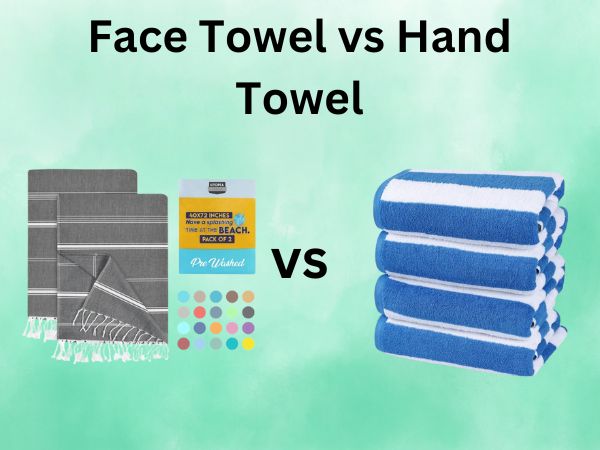Face Towel vs Hand Towel [What’s the Difference?]
Have you ever grabbed a towel in the bathroom and wondered if you’re using the right one? You’re not alone! The world of bathroom textiles can be surprisingly complex, especially when it comes to distinguishing between face towels and hand towels. While they might seem similar at first glance, these bathroom essentials serve different purposes and have distinct characteristics that make them unique.
In this comprehensive guide, I’ll walk you through everything you need to know about face towels versus hand towels. We’ll explore their differences, specific uses, and how to choose the right one for your needs. By the end, you’ll be a towel expert ready to optimize your bathroom setup!
Table of Contents
Understanding Bathroom Textiles
The Evolution of Bathroom Linens
Bathroom textiles have come a long way since their humble beginnings. Did you know that dedicated bathroom towels are relatively modern inventions? Before the 19th century, households often used general-purpose cloths for drying both hands and faces!
Today’s specialized bathroom linens reflect our growing understanding of hygiene and comfort. The differentiation between face towels and hand towels emerged as people recognized the benefits of having dedicated textiles for specific body parts.
Importance of Using Dedicated Towels
Using the right towel for the right purpose isn’t just about being fancy – it’s about maintaining proper hygiene. Your hands encounter countless surfaces and bacteria throughout the day, while your face requires gentler treatment and cleaner contact surfaces.
Having separate towels for your face and hands helps prevent cross-contamination and the spread of bacteria. It’s especially important if you have sensitive skin or are prone to breakouts. Think of it this way: would you want to dry your freshly washed face with the same towel everyone in the house has been using for their hands?
Face Towels: The Complete Guide
What Defines a Face Towel?
A face towel (sometimes called a washcloth) is specifically designed for use on your face. These smaller towels are meant for gentle cleansing, removing makeup, and drying your facial skin after washing. Their primary purpose is to provide a dedicated, clean surface for your most sensitive skin.
I personally find face towels essential for my skincare routine. They’re perfect for removing facial cleansers and providing gentle exfoliation without irritating my skin.
Standard Dimensions and Materials
Face towels are typically the smallest towels in your bathroom collection, measuring approximately 12 x 12 inches (30 x 30 cm). This compact size makes them perfect for precise facial cleaning and easy to handle when washing your face.
Common Face Towel Fabrics
The most popular materials for face towels include:
- Egyptian Cotton: Luxuriously soft with excellent absorbency, perfect for sensitive skin
- Turkish Cotton: Slightly less soft than Egyptian cotton but extremely durable
- Microfiber: Quick-drying with antimicrobial properties, great for acne-prone skin
- Bamboo: Naturally antimicrobial with environmentally friendly credentials
- Modal: Incredibly soft with excellent moisture-wicking properties
Ideal GSM for Face Towels
GSM (grams per square meter) measures the density and weight of towel fabric. For face towels, the ideal GSM typically ranges from 300-600. This medium weight provides the perfect balance of softness and absorbency without being too heavy against delicate facial skin.
Face towels with around 400-500 GSM offer excellent performance for most people – plush enough to feel luxurious but not so heavy that they take forever to dry.
Hand Towels: Everything You Need to Know
Defining Characteristics of Hand Towels
Hand towels serve a specific purpose in your bathroom ecosystem – they’re designed primarily for drying your hands after washing. These mid-sized towels hang conveniently by your sink, providing a dedicated drying solution that prevents the spread of germs.
Unlike face towels, hand towels need to withstand frequent use throughout the day. They’re the workhorses of your bathroom, used by everyone who washes their hands.
Typical Sizes and Materials
Hand towels are medium-sized bathroom linens, typically measuring around 16 x 28 inches (40 x 70 cm). This size makes them easy to hang on towel rings or bars while providing enough surface area for thorough hand drying.
Popular Hand Towel Fabrics
Hand towels come in various materials, each with unique benefits:
- Cotton: The most common choice, offering excellent absorbency and comfort
- Cotton-Polyester Blends: More durable and quicker to dry than pure cotton
- Turkish Cotton: Known for becoming softer and more absorbent with each wash
- Microfiber: Ultra-quick drying with antimicrobial properties
- Linen: Highly absorbent with natural antibacterial properties
Optimal GSM for Hand Towels
Hand towels typically feature a GSM between 400-700. This higher density provides the durability and absorbency needed for frequent hand drying. Since hand towels see more action than face towels, this higher GSM helps them maintain their performance through numerous uses and washes.
I’ve found that hand towels with around 500-600 GSM offer the best balance between quick drying and durability for everyday use.
Key Differences Between Face and Hand Towels
Size Comparison
The most obvious difference between face and hand towels is their size:
- Face towels: Typically 12 x 12 inches (30 x 30 cm)
- Hand towels: Usually 16 x 28 inches (40 x 70 cm)
This size difference exists for practical reasons. Face towels are small enough for precise facial cleansing, while hand towels provide more surface area for quick and thorough hand drying.
Material and Texture Differences
While both towel types can be made from similar base materials, face towels are often crafted to be gentler and softer. Their textures tend to be more delicate to accommodate sensitive facial skin.
Hand towels, conversely, are typically more robust with a slightly rougher texture that can withstand frequent use. They prioritize durability and absorbency over ultra-softness.
Intended Usage Differences
The primary distinction lies in their intended purpose:
- Face towels: Designed for facial cleansing, makeup removal, and gentle exfoliation
- Hand towels: Created specifically for drying hands after washing
Think of it this way: face towels are part of your skincare routine, while hand towels are everyday utility items.
Hygiene Considerations
From a hygiene perspective, keeping these towels separate is crucial. Your hands contact numerous surfaces throughout the day, collecting various bacteria. Using the same towel for both hands and face can transfer these bacteria to your facial skin, potentially causing breakouts or irritation.
I’ve noticed significantly fewer skin issues since implementing dedicated face towels in my bathroom routine!
Choosing the Right Towel for Your Needs
When to Use a Face Towel
Reach for a face towel when:
- Washing your face as part of your skincare routine
- Removing makeup or facial masks
- Applying toner or other skincare products
- Gently exfoliating your face
- Cooling your face (when dampened with cold water)
Face towels should be changed frequently – ideally after every 1-2 uses – to prevent bacteria buildup.
When to Use a Hand Towel
Use a hand towel when:
- Drying your hands after washing
- Quick-drying small body areas after a shower
- Wiping down bathroom surfaces
- As guest towels in your bathroom
Hand towels should be replaced every 2-3 days, depending on household size and usage frequency.
Can They Be Used Interchangeably?
While technically possible, using these towels interchangeably isn’t recommended for optimal hygiene and skincare. Your face deserves a dedicated, clean towel that hasn’t been exposed to the various bacteria your hands encounter throughout the day.
That said, in a pinch, using a fresh hand towel for your face is better than using a shared, potentially bacteria-laden face towel. The key is ensuring whatever touches your face is clean.
Care and Maintenance Tips
Washing and Drying Recommendations
For optimal cleanliness and longevity, follow these care guidelines:
Face Towels:
- Wash after 1-2 uses
- Use mild, fragrance-free detergent
- Avoid fabric softeners (they reduce absorbency)
- Wash in warm water (around 40°C/104°F)
- Tumble dry on low or air dry
Hand Towels:
- Wash every 2-3 days
- Use regular detergent
- Add vinegar occasionally to remove soap buildup
- Wash in hot water (around 60°C/140°F) to kill bacteria
- Tumble dry completely to prevent mildew
Extending Towel Lifespan
To get the most out of your bathroom textiles:
- Rotate your towels regularly to distribute wear evenly
- Always ensure towels dry completely between uses
- Avoid bleach, which weakens fibers over time
- Shake towels out before hanging to maintain fluffiness
- Store in well-ventilated areas to prevent mustiness
I’ve found that hanging towels spread out (rather than folded over a bar) dramatically improves drying time and reduces mildew issues.
FAQs About Face Towels and Hand Towels
1. How often should I replace my face and hand towels completely?
While proper care extends towel life, even the best towels eventually wear out. Replace face towels every 6-12 months and hand towels every 1-2 years, depending on quality and usage frequency. Signs it’s time for replacement include thinning fabric, persistent odors despite washing, and reduced absorbency.
2. Can microfiber towels be used for both face and hands?
Yes, microfiber towels can work well for both purposes, but you should still maintain separate towels for each use. Microfiber’s antimicrobial properties make it excellent for both applications, though you might prefer different thicknesses – thinner for face and thicker for hands.
3. Are organic cotton towels worth the higher price for face towels?
For many people with sensitive skin, organic cotton face towels are absolutely worth the investment. They’re grown without harsh pesticides and processed without aggressive chemicals, making them gentler on delicate facial skin. If you have reactive skin or conditions like eczema, organic cotton face towels can make a noticeable difference.
4. Should children have their own dedicated face and hand towels?
Absolutely! Children benefit from the same hygiene practices as adults. In fact, teaching kids to use separate face and hand towels helps establish good hygiene habits early. Color-coding towels by family member can make this system easier for everyone to follow.
5. What’s the most eco-friendly option for face and hand towels?
Bamboo and organic cotton towels offer excellent eco-credentials. Bamboo requires minimal water and no pesticides to grow, while organic cotton eliminates harmful chemicals from the growing process. For maximum sustainability, look for towels made from organic, rain-fed crops with natural dyes and certified ethical manufacturing practices.
Conclusion
The face towel vs hand towel debate might seem trivial at first glance, but these distinct bathroom textiles serve important and different purposes. Face towels provide gentle care for your sensitive facial skin, while hand towels offer durable, frequent-use solutions for hand drying.
Maintaining separate towels for these different functions isn’t just about bathroom organization – it’s about proper hygiene and skincare. By understanding the differences and using each towel type appropriately, you’ll create a more hygienic bathroom environment while potentially improving your skin health.
Remember, the best bathroom setup includes dedicated towels for specific purposes. Your face deserves its own clean, soft towel, just as your hands benefit from a sturdy, absorbent hand towel. This simple distinction makes a significant difference in your daily hygiene routine.


![Hand Dryers vs Paper Towels [Which Is the Better Choice for Your Restroom?]](https://bathroomexplorer.com/wp-content/uploads/2025/02/Hand-Dryers-vs-Paper-Towels.jpg)
![5 Best Cooling Towels for Golf [Beat the Heat and Improve Your Game]](https://bathroomexplorer.com/wp-content/uploads/2025/02/Best-Cooling-Towels-for-Golf.jpg)


![How to Hang Towels in Bathroom [A Complete Guide]](https://bathroomexplorer.com/wp-content/uploads/2024/09/How-to-Hang-Towels-in-Bathroom.jpg)
![5 Best Beach Towels for Boating [In 2025]](https://bathroomexplorer.com/wp-content/uploads/2025/02/Best-Beach-Towels-for-Boating.jpg)